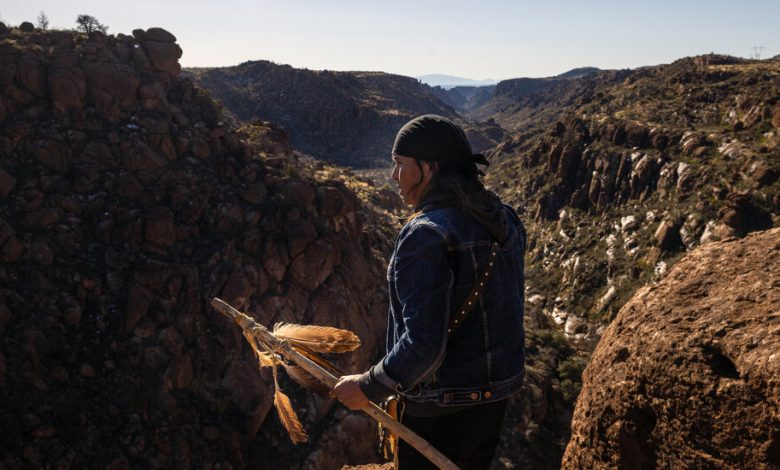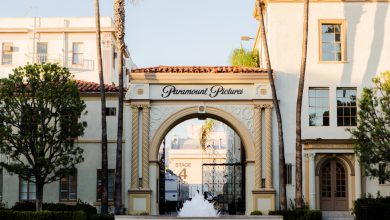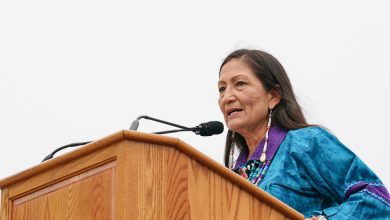A Copper Mine Could Advance Green Energy but Scar Sacred Land

SUPERIOR, Ariz. — As Wendsler Nosie finished his evening prayers sitting before a mesquite fire, a ceremonial yucca staff festooned with eagle feathers by his side, he gazed sternly toward a distant mesa where mining companies hope to extract more than a billion tons of copper.
That mine could help address climate change by helping the United States replace fossil fuels and combustion engines with renewable energy and electric cars. But to Mr. Nosie, a former chairman of the San Carlos Apache Tribe, it’s the latest insult in a bitter history. The tribe considers the rolling hills and hidden canyons under which the copper lies — an area of Arizona called Oak Flat — to be a corridor to God inhabited by holy spirits. The tribe’s reservation is roughly 35 miles away.
“We’re confronting that big dominant way, this corporate way of life,” he said. “It’s two ways of thinking clashing. There is no room for both. One will be destroyed.”
The two mining giants behind the project, Rio Tinto and BHP, have plenty of experience with conflicts over the environment. But in this case, executives for the companies have argued that their project, known as Resolution, will benefit the environment by helping to increase the use of renewable energy and electric cars and reduce emissions of greenhouse gases. The companies have already spent more than $2 billion on exploratory work and to prepare for the project. They have the support of many local and state elected officials.

A monument at the site of Old San Carlos, memorializing the hardship faced by the Apaches. The tribe considers the land where the copper lies to be a corridor to God inhabited by holy spirits.
“Copper is critical for the energy transition,” said Vicky Peacey, the mine’s project director. “Climate change is the single biggest crisis facing the world. We have to do this right.”
The battle over copper in southern Arizona highlights a growing dilemma for policymakers and investors eager to move from fossil fuels to clean energy. Making that switch will require new mines, sometimes in pristine and sacred lands, to extract a lot more copper, lithium and other metals. Extracting coal, oil and gas has significant environmental costs, too, but they often come from places, like Louisiana, New Mexico, Texas and Wyoming, with established mines and oil and gas fields and scant local opposition to those businesses.
Copper is abundant in the Western Hemisphere, so its availability has been taken for granted. The United States was nearly self-sufficient in copper until the 1990s. But because demand is growing fast and older mines have been depleted, domestic sources provide just half the country’s needs.
The United States could be importing two-thirds of its copper by 2035, according to S&P Global. Relying on other countries might not be a good strategy, energy experts said, because copper-rich countries like Peru and Chile are also struggling to produce more as a result of political turmoil and growing opposition to mining.
At stake are the ambitious climate goals set by President Biden, who wants to reduce U.S. greenhouse gas emissions by 50 to 52 percent from 2005 levels by 2030 and effectively bring them to zero by 2050. To meet those targets, the country will need many more wind turbines, solar panels and electric vehicles — and all of those will require a lot more copper. An electric car, for example, has three times as much copper in it as a comparable gasoline powered vehicle.
“So much of the energy transformation is about electrification, and copper is the metal of electrification,” said Daniel Yergin, the energy historian and vice chairman of S&P Global. “But in order to meet the 2050 net-zero carbon goals that the United States and European Union have embraced, global copper production has to double, and it’s very hard to see how that is going to happen.”
Ms. Peacey said in an interview that her company was willing to compromise with the local Apache. Executives have already scaled back the scope of their mine from their original proposal. But many Apache leaders say no compromise is possible as long as the miners plan a drilling technique that, over decades, would produce a gaping canyon, killing wildlife and oak trees.
“Would anyone destroy Mount Sinai to drill for oil?” asked Mr. Nosie, who lives as a protest in two caves that will eventually be disturbed if the mine is built. He said he was ready to go to the Supreme Court to defend what he characterized as the Apache’s constitutional right to practice their religion.
Mr. Nosie, 64, said his ancestors inhabited Oak Flat back in the mid-19th century before U.S. soldiers herded them to the reservation where the tribe is still based. As a child, he would visit the area with his grandfather. “He opened up my eyes,” Mr. Nosie recalled.
Mr. Nosie’s efforts have already helped to stall the project for years, and years more of delays are likely.



Historic images of Arizona mining, left, at Resolution’s East Plant and core samples, right, at the processing facility. Vicky Peacey, center, the mine’s project director, is willing to compromise with the local Apache.
U.S. copper production, currently 1.2 million metric tons a year, has been dropping because the nation’s biggest mine, the Morenci in Arizona, is declining and may be exhausted in 20 years. The proposed Resolution mine, 6,800 feet underground and 60 miles east of Phoenix, would produce an estimated 40 billion pounds of copper over 40 years, according to Rio Tinto.
The Resolution mine project was initially made possible nine years ago when Senator John McCain, an Arizona Republican, slipped a federal land swap in an appropriations bill that could eventually open the Oak Flat area to more copper mining. A 2,400-acre tract of Tonto National Forest, which includes Oak Flat, would be exchanged for parcels controlled by Resolution within 60 days after a regulatory process concluded.
A required environmental review was completed in the final days of the Trump administration, but the U.S. Forest Service halted the swap in 2021 after Mr. Biden became president. The administration has promised to consult extensively with Native American tribes before moving forward with the swap.
Separately, a group led by Mr. Noise and Becket, a conservative nonprofit organization formerly known as the Becket Fund for Religious Liberty, is seeking an injunction to stop the land exchange until the merits of religious issues are resolved by the legal system.
A federal court rejected their motion, a decision affirmed by a three-member panel of the U.S. Court of Appeals for the Ninth Circuit in June. The full Ninth Circuit will hear an appeal this year. Two other federal lawsuits that argue that the mine would violate environmental and historical preservation statutes have been filed.
A spokesman for the Agriculture Department, which includes the Forest Service, said officials could not comment because of the litigation. But Biden administration officials have sought to walk a fine line between respecting the views of tribes and environmentalists opposed to specific projects and the president’s desire to increase domestic production of important raw materials.
There are differing opinions on the merits of mining even on the San Carlos Apache reservation. Some people view the mine as an affront to their traditions, while others consider it an economic opportunity and a source of employment.
“It’s a job opportunity, and I’m a single parent,” said Jolene Quade, 35, who sells fry bread from a street cart in San Carlos.
Juaniko Goseyun, a 22-year-old freelance videographer, said his views were shaped by a visit to Oak Flat and a discussion about the mine with Mr. Nosie in a class.
“It made me feel that if there is going to be a mine, all that is old and sacred to us will be lost,” he said, referring to the Apache petroglyphs and fire pits he saw on his visit to Oak Flat.
Some environmentalists also oppose the project, arguing that it would eventually reduce habitat for endangered species, including the hedgehog cactus and narrow-headed garter snake. Pumped underground water could pollute rivers and streams.
“There’s going to be mining, but that doesn’t mean there has to be mining in every location,” said Sandy Bahr, director of the Sierra Club Grand Canyon chapter.
Ms. Peacey counters that the Resolution site is one of just a few great and accessible stores of copper left. “It’s like looking for a needle in a haystack,” she said. She said the company’s plans for storing mine waste, or tailings, “will meet the most stringent design criteria of any global standard.”
The mine will be outfitted with extensive sensors, autonomous vehicles and climate control systems that operate more than a mile below the surface, where temperatures can reach 175 degrees. The mine will cost billions of dollars more, and is expected to produce 1.4 billion tons of ore over 40 years.
As an elevator takes mine employees down a shaft 500 feet a minute, there is a piercing clang of cooling fans and the hiss of compressed air. A few dozen electricians, mechanics and welders are maintaining water systems and studying the mine.
Construction could take eight to 10 years, and the mine could eventually employ 3,700 workers, according to Resolution, reviving Superior, an old mining town.
There is an abundance of copper in Arizona, said Kray Luxbacher, head of the University of Arizona’s department of mining and geological engineering, but there are daunting legal hurdles to starting new mines or smelting plants.
“The intentions of the Biden administration are good, but they’re not going to get this done unless they find a way to come up with the raw materials,” she said.
Goldman Sachs predicts that global demand for copper will top supplies by 2025.
“I’m much more worried about copper than lithium, because if you are a battery manufacturer you can find ways to use less lithium,” said Michael Webber, a professor of mechanical engineering at the University of Texas at Austin. “Copper is a big deal for electric vehicles, but it’s also a big deal for wind and solar and batteries and transmission lines and even nuclear power plants.”
Recycling could help, but building enough capacity to reuse copper in large volumes could take a decade or so, energy experts said.
That leaves Arizona. The mayor of Superior, Mila Besich, is eager to usher in a mining renaissance but is not overly optimistic.
“The mine is sitting in bureaucratic purgatory,” she said. “It can’t be all or nothing, and that’s the problem.”



